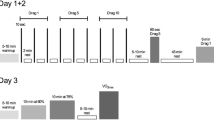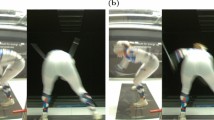Summary
Oxygen consumption [(\(\dot V_{{\text{O}}_{\text{2}} } \)) in ml·kg−1·min−1], blood lactate concentration ([La] in mM) and dynamic friction of the skis on snow [(F) inN] were measured in six athletes skiing on a level track at different speeds [(v) in m·min−1] and using different methods of propulsion. The\(\dot V_{{\text{O}}_{\text{2}} } \) increased withv andF, the latter depending mostly on snow temperature, as did [La]. The\(\dot V_{{\text{O}}_{\text{2}} } \) was very much affected by the skiing technique. Multiple regression equations gave the following results: with diagonal stride (DS),\(\dot V_{{\text{O}}_{\text{2}} } \) =−23.09+0.189v+0.62N; with double pole (DP),\(\dot V_{{\text{O}}_{\text{2}} } \) =−30.95+0.192v+0.51N; and with the new skating technique (S),\(\dot V_{{\text{O}}_{\text{2}} } \) =−32.63 +0.171+0.68N. In terms of\(\dot V_{{\text{O}}_{\text{2}} } \) DS is the most expensive technique, while S is the least expensive; however, asF increases, S, at the highest speed, tends to cost as much as DP. At speeds from 18 to 22 km·h−1, the speeds measured in the competitions, theF for DS and DP can represent from 10% to 50% of the energy expenditure, withF ranging from 10 to 60N; with S this range increases to 20%–70%. This seems to depend on the interface between the skis and the snow and on the different ways the poles are used.
Similar content being viewed by others
References
Bergh U (1987) The influence of body mass in cross-country skiing. Med Sci Sports Exerc 19:324–331
Cavagna GA, Saibene F, Margaria R (1963) External work in walking. J Appl Physiol 18:1–9
Cavagna GA, Saibene F, Margaria R (1964) Mechanical work in running. J Appl Physiol 19:249–256
Christensen EH, Högberg P (1950) Physiology of skiing. Arbeitsphysiologie 14:292–303
MacDougall JD, Hughson R, Sutton JR, Moroz JR (1979) The energy cost of cross-country skiing among elite competitors. Med Sci Sports 11:270–273
Margaria R (1938) Sulla fisiologia e specialmente sul consumo energetico delia marcia e della corsa a varie velocita ed inclinazioni del terreno. Atti Real Accad Naz Lincei 7:299–368
Niinima V, Dyon M, Shephard RJ (1978) Performance and efficiency of intercollegiate cross-country skiers. Med Sci Sports 10:91–93
Outwater JD (1970) On the frictions of the skis. Med Sci Sports 2:231–234
Pugh LGCE (1976) Air resistance in sport. In: Jokl E, Anand RL, Stoboy H (eds) Medicine and Sport. Advances in exercise physiology, vol. 9. Karger, Basel, pp 149–164
Author information
Authors and Affiliations
Rights and permissions
About this article
Cite this article
Saibene, F., Cortili, G., Roi, G. et al. The energy cost of level cross-country skiing and the effect of the friction of the ski. Europ. J. Appl. Physiol. 58, 791–795 (1989). https://doi.org/10.1007/BF00637393
Accepted:
Issue Date:
DOI: https://doi.org/10.1007/BF00637393




